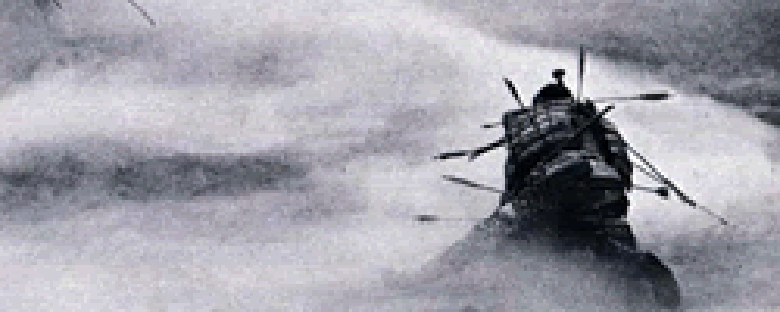Reviews
Kumonosu-jo
Akira Kurosawa
Japan, 1957
Credits
Review by Rumsey Taylor
Posted on 11 July 2004
Source The Criterion Collection DVD
The opening scenes of Akira Kurosawa’s Throne of Blood are covered in an ethereal, dense fog. The effect is tangibly productive; it is a familiar special effect, which, in this emphasized use, suggests a spiritual presence, a prophecy that determines the fate of expendable human characters — pawns for the dramatic benefit of classic Shakespearean tragedy. It is theatrical material whose heritage is attuned to the stage, and is redone here with the might of Kurosawa’s helm.
In a particular instance, reluctant heroes Washizu and Miki find themselves trapped and blinded within the fog. They ride away and then towards the frame, often in an unbroken shot, and begin to evaluate a prior encounter with a forest witch, that the circumstance is tied to her discordant prophecy in which they will each soon afford great military promotion. Her words bore the implication that hubris will activate their demise and vengeance will replace their honor.
Throne of Blood takes substantial liberties with Macbeth in its location and dialect (expected, given the filmic tendency to depict Shakespeare in foreign scenarios). When seen in comparison to other works in Kurosawa’s catalogue, Throne of Blood is an uncharacteristic example, inhumane and atmospheric, noticeably dissimilar to the legendary director’s chronologically local efforts. Although directly complimentary to the director’s Ran(taken from King Lear), Throne of Blood is truncated and therefore more accessible alongside its companion adaptation.
An element absent here and apparent in much of Kurosawa’s work is the depth, bounty, and expansiveness of a fictional narrative (Throne of Blood is especially stark alongside Seven Samurai, which it followed by three years). And granted, this is a moot criticism, given that it is an adaptation of a familiar work (which Kurosawa displays deft understanding of), and because it is book-ended, as was Macbeth, by a prophetic chorus; the conclusion is delivered in the film’s opening minutes. The conflict is the trap of predestined fate. Thusly, interest in this film lies in Kurosawa’s depiction of specific climaxes from the source. The early appearance of a prophetic witch, for example, is uniquely frightening.
As in Seven Samurai, Kurosawa’s films propagate moralistic scenarios in which ethics are drawn in individual choice. Throne of Blood is objectively and moralistically distant — literally, as much action is viewed from behind a veil of bushes and trees, investing a voyeuristic and impersonal quality. Here, characters are individually dictated at the patronizing whim of spiritual forces. There is also a supernatural element. Action scenes in which Washizu rides through the impermeable forest, which sparingly display Kurosawa’s action cinematography, are scored with howls and gaggles by unseen sources. The effect is atmospherically evocative, and, again, alien in the bulk of Kurosawa’s catalogue.
Its primary source subject to familiarity and its author’s trademark apparent, Throne of Blood is nonetheless original, liberally inspired by multiple sources and seen, in result, as a singular novelty.
note: The Criterion DVD has two subtitle channels. Both are different in specific delivery, and are of note for the differentiated language they lend the film. The booklet also includes an essay from each subtitle author.
We don’t do comments anymore, but you may contact us here or find us on Twitter or Facebook.



